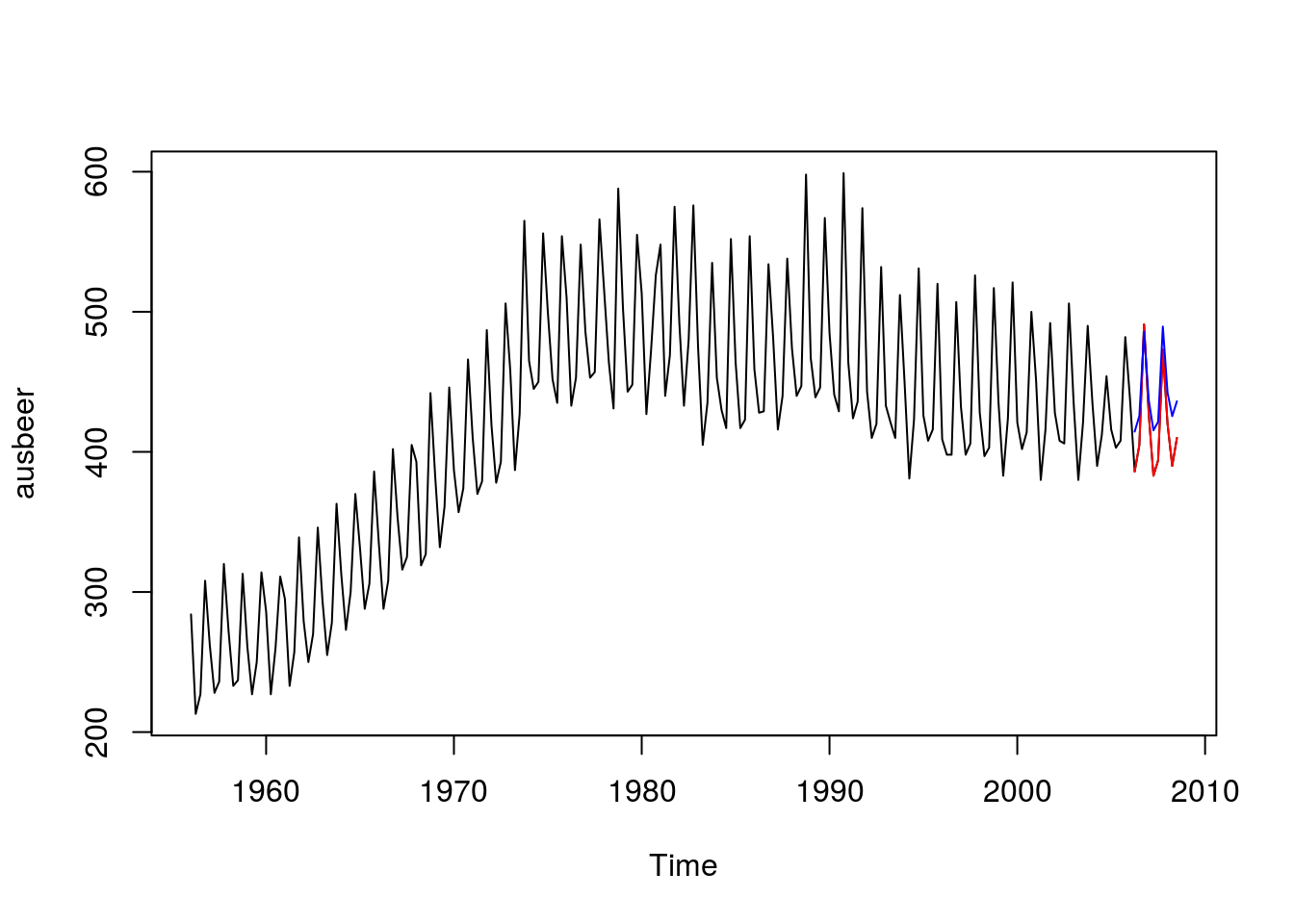NARX Model Guide
Farzad
15 August 2016
Setup
For the rest of this guide, we will use time-series ausbeer from package fpp:
library("fpp")
beer_train = head(ausbeer, -20)
beer_test = head(tail(ausbeer, 20), 10)NARX Model
A simple NARX model can be crafted using narx. A model with
- differencing order
d=0 - auto-regressive order
p=2 - seasonal frequency
freq=4 - seasonal differencing order
D=1 - seasonal order
P=1 svmlearner
can be instantiated as follows:
library("mltsp")
library("e1071")
spec = build_narx(svm, p=2, d=0, P=1, D=1, freq=frequency(ausbeer))
model = narx(spec, beer_train)
model## NARX svm(2, 0)(1, 1)[4]or alternatively:
model = narx(beer_train, svm, p=2, d=0, P=1, D=1, freq=frequency(ausbeer))Duplicating the model
One could re-instantiate the model for use with another dataset using
beer_train2 = head(ausbeer, -10)
model2 = narx(model, beer_train2)Prediction
Prediction uses either forecast (compatible with package forecast):
fcst = forecast(model, h = 10)
plot(fcst)
lines(beer_test, col="red")
or use predict if you want to also supply new data but use the same model:
beer_train2 = head(ausbeer, -10) # this is using data from another future!
beer_test2 = tail(ausbeer, 10) # this is using data from another future!
fcst2 = predict(model, beer_train2, h = 10)
plot(ausbeer)
lines(beer_test2, col="red")
lines(fcst2, col="blue")
Alternatively, one could reuse the model using
model2 = narx(model, beer_train2)
fcst3 = forecast(model2, h = 10)
plot(fcst3)
lines(fcst2, col="red")
Using exogenous data
Use xreg parameter as exogenous data. This example tries to forecast a random walk. Without xreg, this should be almost impossible:
set.seed(0)
tstamps = seq(as.Date("2000-01-01"), length.out = 110, by='day')
x = xts(runif(length(tstamps)), tstamps)
xreg = 1 - 0.5 * x
yreg = xts(runif(110), tstamps)
colnames(xreg) = colnames(yreg) = "xreg"
# training and testing data
x_train = head(x, 100)
x_test = tail(x, 10)
ind_test = index(x_test)For simplicity, we use SimpleLM as the learner, which is a simple wrapper for lm. * lm is not compatible with narx as it requires a formula. SimpleLM allows using a linear model without resorting to crafting formulas, similar to what svm from package e1071 does.
Model one, without xreg:
model = narx(x_train, SimpleLM, p = 2)
pred1 = forecast(model, h=10)Model two, with correlated (good) xreg:
model2 = narx(x_train, SimpleLM, p = 2, xreg = xreg)
pred2 = forecast(model2, xreg=xreg[ind_test])Model three, with an uncorrelated (bad) xreg:
model3 = narx(x_train, SimpleLM, p = 2, xreg = yreg)
pred3 = forecast(model3, xreg=yreg[ind_test])The results:
rmse <- function(x,y) sqrt(mean((x-y)^2))
c(Err_without_xreg= rmse(pred1$mean, x_test),
Err_with_xreg= rmse(pred2$mean, x_test),
Err_with_bad_xreg= rmse(pred3$mean, x_test))## Err_without_xreg Err_with_xreg Err_with_bad_xreg
## 2.755231e-01 1.570092e-16 2.985320e-01The smallest error is obtained from the model with correlated xreg.
Notes
- Some ML models, such as
SimpleLM, require the same column names in training and testing to fit data. - Instead of
has the forecast horizon,xregand its time-stamps are used.